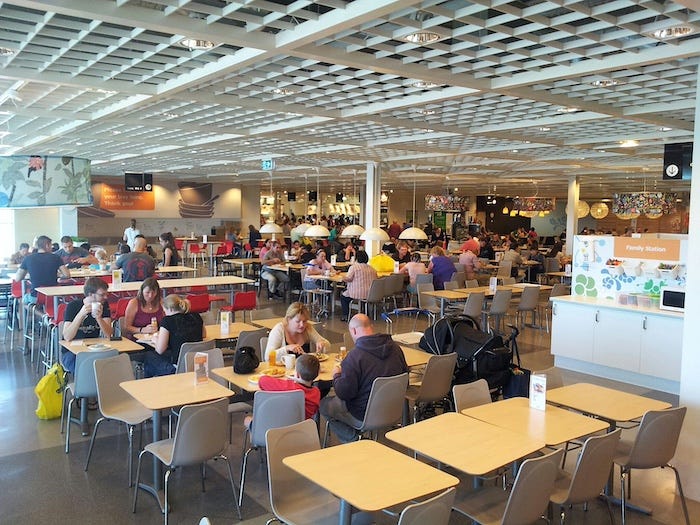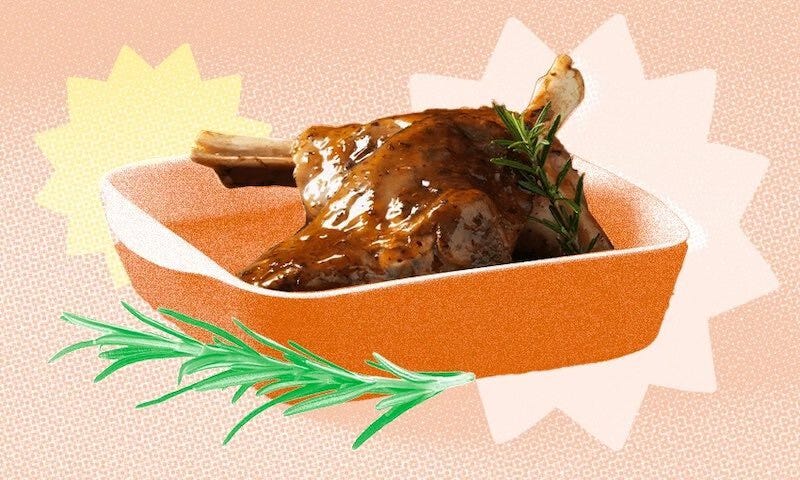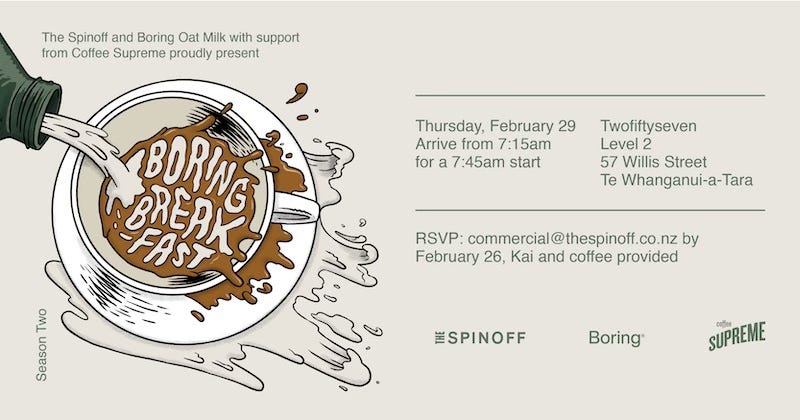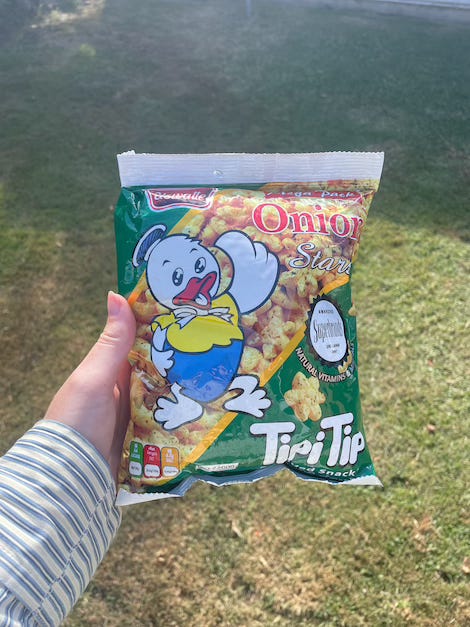Nau mai, haere mai. Welcome to The Boil Up, The Spinoff’s weekly food newsletter, newly edited by me, Lucinda Bennett. I hope you enjoy my first edition!
Having recently announced her new role as food editor at Metro, Charlotte Muru-Lanning noted the pressure of filling the big boots left by her predecessor, and now here I am to say the same – although I am looking forward to walking in them. A little bit about me: I’ve been talking kai weekly on 95bfm Breakfast Food (Thursdays at 8.10am!) for almost a year, a writer for about a decade (mostly about art) and obsessed with food my entire life – cooking it, eating it, reading, chatting, dreaming about it and now, writing about it!

When I really think about my approach to food – my philosophy of food, if you will – I always come back to a text I consider sacred, Rebecca May Johnson’s I Dream of Canteens. Like Johnson, I dream of a space that is mythical when it should be common, a space with ample seating for all bodies, access to glasses of water, clean bathrooms and cheap, nourishing food. It’s a space where you can come alone or with a large group, where you can stay as long as you need and not be made to feel unwelcome once a certain period of time has elapsed since you spent money. This dream space is as rare in Aotearoa as it is in London, where Johnson writes from, although she does describe her experiences of dining at IKEA canteens (something Tāmaki residents will get to try next year) as coming close, noting, “I experienced high levels of pleasure when eating and sitting and I witnessed many others who seemed to feel the same… If such a place existed in the city, I would go there every day.”
Where can we go, when we need to sit for a while and eat a plate of affordable, sustaining kai? I think of food courts, the ones inside malls but also tucked away in more industrial areas, like Delicious Link in Wairau Valley where my Mum and I took shelter one sweltering afternoon to share a bento box, a bowl of takoyaki and an incredible lychee milkshake. I think of the anonymity of fast food outlets that enables you to linger long over something from the saver menu or even use the bathroom without buying anything. I think about the Kaife I used to go to every day at AUT South Campus where a hot, calorie-dense lunch would cost only $6 (now $8, it seems). My class’s favourite was Island Day when they had palusami, chop suey and paifala for dessert, and every Wednesday was reliably Pie Day, choose from two options with a rotating cast of veggie sides, buttered sweetcorn, scalloped potatoes, sweet roasted carrots. Then there are the RSA Halls across the motu where a generous plate of fish and chips might only set you back $10; takeaway shops with bain-maries of oily fried rice, beef noodles, golden wontons and a picnic table out front; community restaurants like Everybody Eats that provide sustenance alongside dignity and pleasure, serving chef-prepared, three-course meals on a pay-as-you-feel basis.
Delving into the history of canteens, Johnson learned about “British Restaurants”, state-subsidised canteens that were set up during wartime “to serve cheap hot food for everyone so that people had enough to eat things like semolina and stew.” After the war, the conservative government phased the Restaurants out, despite parliamentary discussions around the “astonishing improvements” noted in the wellbeing of workers. When I worked as a teacher, I observed something similar when I moved to a school that was part of the Ka Ora, Ka Ako programme that provides healthy lunches for every student, every day.

You don’t have to be a rocket scientist to understand that people operate better when they’re well-fed. I’m certainly better after a cheese toastie or a steaming bowl of ramen. Perhaps the reason I hold Johnson’s essay so dear is because it speaks so personally, so tangibly, to this truth, all while pointing out that a solution already exists, has existed. It’s also an essay that showed me the expansive possibilities for food writing, swirling together history, accessibility, packed lunches, Homer’s Odyssey, IKEA, politics and frozen peas (it’s worth reading the whole thing). Thinking about this newsletter going forward, I’m interested in such seemingly disparate realms swirling together under the banner of food, considering how the world shapes kai and is shaped by it, and so, in turn, are we.
What is National Lamb Day?
Thursday 15 February marked National Lamb Day, and Beef + Lamb New Zealand encouraged everyone to celebrate. But what is National Lamb Day and what can we do to show our support? The Spinoff asked Beef + Lamb New Zealand CEO Kit Arkwright to explain.
Read the article, in partnership with Beef + Lamb New Zealand on The Spinoff now. (sponsored)
Weekly bites
In a world ruled by SEO (Search Engine Optimisation), the ability to describe one’s business accurately is paramount. Until recently, Google did not include “Palestinian” as a restaurant category, forcing Palestinian restauranteurs to use the generic “Middle Eastern” despite other country-based descriptors such as “Israeli” or “Lebanese” being allowed. After years of campaigning by small businesses, the change has finally been made and restaurants can at last call themselves ‘Palestinian’ on the search engine.
If you want to liven up your staffroom on a Friday morning, I recommend asking where to get the best hot cross bun. It is a real treat to witness colleagues driven to the verge of tears for trying to defend the chocolate hot cross bun’s right to exist. If things get really out of hand, you can pull out the results from the 2024 Hot Cross Bun Awards and inform everyone that actually, Auckland’s Daily Bread has the best buns because they’ve now taken the top prize three years in a row—something no bakery has ever achieved before! Second and third place were awarded to Remuera bakery Knead on Benson and Wellington’s Nada Bakery respectively. If you’re unwilling to fork out over $20 for half a dozen buns, our 2023 rankings of supermarket HCBs still holds true.
Sad news for soft cheese lovers: Camembert is “on the verge of extinction” according to a report from the French National Centre for Scientific Research (CNRS). The problem stems from a lack of microbial diversity as all Camembert the world over is inoculated exclusively with one single strain of Penicillium camemberti. For reasons that aren’t entirely clear, the signature snow white mould we’ve come to expect on our cheese platters cannot reproduce sexually, requiring cheesemakers to clone it. Decades of replicating this one strain has introduced errors into its genome that are making it much harder to clone. No need to despair just yet, though. As much as we love it, Penicillium camemberti is not the only mould present in raw milk and cheese producers are already working hard to introduce these to the mix. This means our camembert and brie may look a little different and taste a little funkier in the future, but this diversity is how we save our cheese.
The Spinoff and Boring Oat Milk with the support from Coffee Supreme proudly presents Boring Breakfast - Wellington.
As a compact city with an outsized culinary reputation, Wellington has always taken hospitality very seriously. But as the city moves forward from the disruption of the early 2020s, how do those within the sector feel about its current state?
Join us as Boring Breakfast visits Te Whanganui-a-Tara for the very first time, with host Sophie Gilmour (Delicious Business) welcoming guests Douglas Johns (Coffee Supreme), Juno Miers and Thomas Adam (Margot) to discuss what they do, why they do it and their hopes for the city's hospo future. If you would like to attend, please RSVP to: commercial@thespinoff.co.nz by February 26
Snack of the week
Tipi Tip Onion Stars Extruded Snack, $2.99 from Serandib in Mt Roskill, Auckland. Did I pick these up because of the sassy little duck in a sailor romper on the package? Or because I love novelty shaped foods and couldn’t resist the cute potential of onion stars? Then there was the lovely man at Serandib telling me he preferred these over cassava chips, and so I brought these to the counter along with a tub of mango ice cream, a hot vadai (a savoury spiced donut made from soaked pulses) and a jar of proper Ceylon cinnamon (if you’ve been buying any old packet from the supermarket, I urge you to try find some Sri Lankan cinnamon – thank me later).
I open my Tipi Tip Onion Stars Extruded Snack while working on the couch. Pulling out the first snack, I am delighted by its star-shaped perfection. The flavour is mild and fake-oniony – a positive in my book – reminiscent of sour cream and onion flavoured pringles but far milder. But what really gets me is the crispy (not crunchy) texture, the way these golden stars shatter easily between the teeth. I eat about ten before I finally realise what they remind me of: Australian Twisties, a snack I grew up eating at birthday parties. This makes sense because both snacks are maize/corn-based and extruded to produce their respective signature shapes. While the packaging may boast about their “natural vitamins and minerals”, I’m not sure Tipi Tip’s can be categorised as health food, however, with only three ingredients listed – maize grit, vegetable oil and “nature identical onion flavour” – they are probably slightly less unhealthy than other refined snack options. But health is not the point when you buy a crackly packaged snack with a cartoon animal on the front. Tipi Tip Onion Stars are for fun and yum, and they rank highly on both counts! 7/10
Mā te wā,
Lucinda
Since the start of the year, Spinoff readers have helped fund some of our most popular and important work. Whether you read, listen to or watch our mahi, you can support us to do more by donating today or signing up to become a Spinoff member.














Haere mai! Good article; I'm now hungry...
Nice piece. I was reminded of a short story I listened to that features a cafeteria. A strange, dreamy, anxious story that lingers long after you’ve finished it.
https://podcasts.apple.com/nz/podcast/the-new-yorker-fiction/id256945396?i=1000581233481